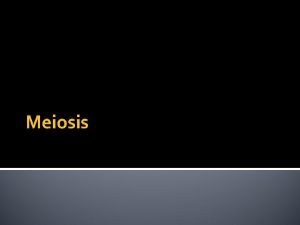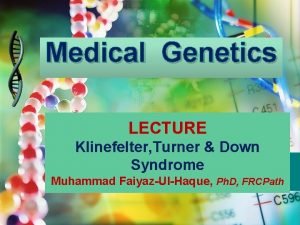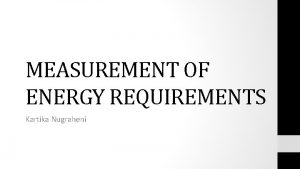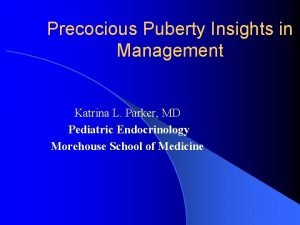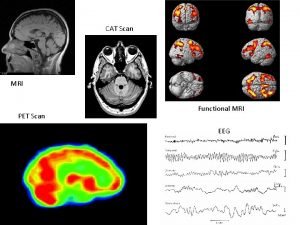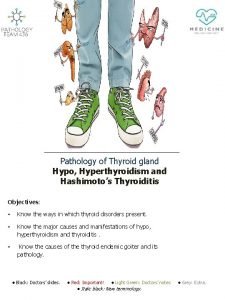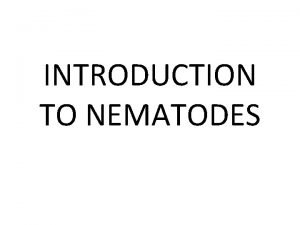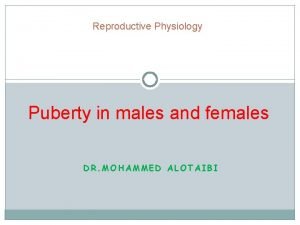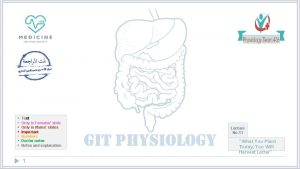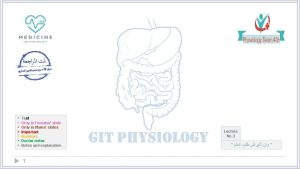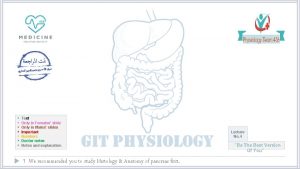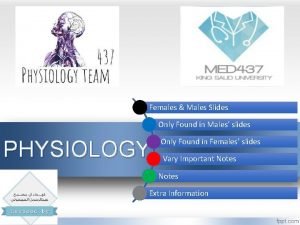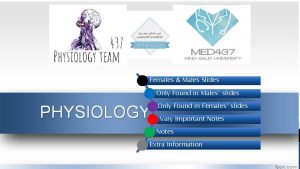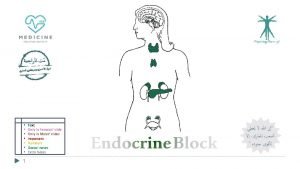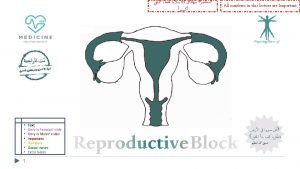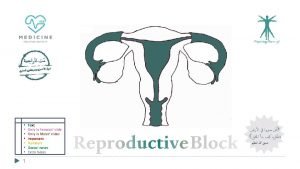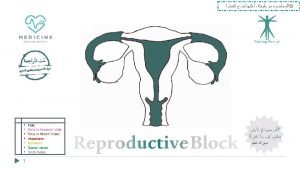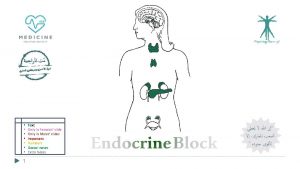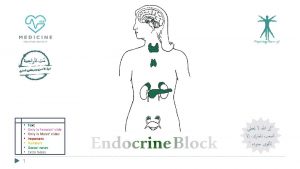Text Only in Females slide Only in Males




















- Slides: 20

§ § § § Text Only in Females’ slide Only in Males’ slides Important Numbers Doctor notes Notes and explanation 1 Lecture No. 7 “Stay Focused And Extra Sparkly” All the videos in this lecture is very helpful

Reticuloendothelial System (RES) & Function of the Spleen Objectives: 2 1. Define the term Reticuloendothelial system (RES). 2. Describe the cellular components of RES. 3. Describe the functions of the RES. 4. Define the structural function of the spleen. 5. Describe the functions of the spleen. 6. Understand the basic concept of the indication and risks of splenectomy. 7. Mechanism of chemotaxis, phagocytosis and microbial killing 8. Functions of monocytes/macrophages in different tissues

Only in Males’ Slides Overview of the immune system Immunity Innate Immunity (non specific) Examples: Complement, Barriers, Phagocytes (Neut, Mono, NK) Acquired immunity (specific, adaptive) Humoral (T lymphocytes) Cell mediated Antibody mediated (B lymphocytes) Note: Macrophages are key components of the innate immunity and activate adaptive immunity by transforming into Antigen Presenting Cells. 3

Reticuloendothelial system (RES) � Reticuloendothelial System is an older term for the Mononuclear Phagocyte System. � although they are neither reticular (mesh or network) in appearance nor they have endothelial origin just these phagocytic cells are located in reticular connective tissue. � Therefore, the term reticuloendothelial system is not used nowadays. � It is a network of connective tissue fibers inhabited (occupied) By phagocytic cells such as macrophages ready to attack and ingest microbes. � Cellular components of RES Monocytes Macrophage In bone marrow , spleen , lymp node. RES is an essential component of the immune system. � Most endothelial cells are not macrophages. • The total combination of monocytes, mobile macrophages, fixed tissue macrophages, and a few specialized endothelial cells in the bone marrow, spleen, and lymph nodes is called the reticuloendothelial system. • However, all or almost all these cells originate from monocytic stem cells; therefore, the reticuloendothelial system is almost synonymous with the monocyte-macrophage system. Because the term reticuloendothelial system is much better known in medical literature than the term monocyte-macrophage system, it should be remembered as a generalized phagocytic system located in all tissues, especially in the tissue areas where large quantities of particles, toxins, and other unwanted substances must be destroyed. 4 Specialized Endothelial cells Next slides cells that line the interior surface of blood vessels and lymphatic vessels, forming an interface between circulating blood or lymph in the lumen and the rest of the vessel wall. It is a thin layer of simple squamous cells called endothelial cells. Endothelial cells in direct contact with blood are called vascular endothelial cells, whereas those in direct contact with lymph are known as lymphatic endothelial cells.

1 st Monocytes Definition Are a type of white blood cell “leukocyte. ” • They are the largest type of leukocyte and can differentiate into macrophages. • Location In the blood Size 15 -20 µm (active cells 60 -80 µm) Small granules Prim & Vacoules Efficient • • Life span 10 -20 hours in blood & in tissues. Types 1. Mobile (to ingest large particle) 2. Fixed (often in tissue) N. B Picture ü ü 1. 2. 3. Only in Males’ Slides More Efficient Phagocytosis than Neutrophils. 100 bacteria vs 3 -20 by Neutrophils, larger particles like RBCs & malarial parasites. - Lysosomes contain lipases unlike Neutrophils. - Acts as Antigen Presenting Cells. ﺯﻱ ﺣﺪﻭﺓ ﺍﻟﺤﺼﺎﻥ Monocytes transform themselves into macrophages in tissue & this system of phagocytes is called as Monoctye-Macrophage Cell. Characterized by an increase in: Neutrophils is the fastest & most potent chemotactic cell, while the monocyte is slower but stronger in response to the inflammatory process. Cell size. Number and complexity of intracellular organelles Golgi, mitochondria, lysosomes. 5 Intracellular digestive enzymes.

2 nd Macrophages Tissue macrophages provide a first line defense against infection Definition A large phagocytic cell found in stationary form in the tissues or as a mobile form white blood cell, especially at sites of infection. Function - They filter and destroy objects which are foreign to the body, such as bacteria, viruses. - Some macrophages are mobile, and they can group together to become one big phagocytic cell in order to ingest larger foreign particles. - In all tissues. - often remain fixed to their organs. Location Formation of Macrophage s Begin by Stem cell in Bone Marrow Monoblast maturing to promonocyte mature monocytes released into blood Stay for 10 -20 hours in circulation Then leave blood to tissues transforming into larger cells macrophage Macrophage life span is longer up to few months in tissues Life spine 10 -20 hours - months Location Types of Macrophages Macrophage differ depending on the organs in which they reside. Kupffer cells Picture Liver Picture Alveolar cells Tissue histiocytes (Duct cells) Picture, another picture (langerhans cell) (fixed macrophages) Lung “Dust cells” because of their content of intracellular carbon particles. Macrophages Line Nodal Medullary sinuses: 1) subcapsular sinus macrophages (SSMs). 2) medullary sinus macrophages (MSMs). 3) medullary 6 cord macrophages (MCMs). - Skin. - Mucosa. - Subcutaneous tissues. Microglia Reticular cells - Lymph nodes. Brain Sinus histiocytes Picture Lymph nodes. - Bone marrow. - Spleen. Picture Mesangi al cells Hofbauer Epithelioid Picture Osteoclast s Kidneys Bone Placenta Granuloma s

3 rd Neutrophils Definition • • Only in Males’ Slides Neutrophils are a type of white blood cell. In fact, most of the white blood cells that lead the immune system’s response are neutrophils. Most Abundant WBCs 60 -70 %. Size 15 -20 µm Nucleus Multilobed, 2 -5 lobes Life span 6 -8 hours POOLS: “three populations of neutrophils” Bone Marrow pool Circulating pool Marginating Pool Neutrophils within bone marrow. Neutrophils within blood. Neutrophils adherent to endothelium in low flow exchange vessels. Neutrophil granules Monocytes contain primary granules and vacoules only, neutrophils Contain glycogen granules. Why it contain glycogen granules? for anaerobic glycolysis. Primary Granules ü Non Specific. ü 33% ü Azurophilic. Lysosomes contain: - Acid hydrolases. - MPO. - HOCl. - Defensins Secondary Granules ü Specific ü 67% Granules contain: - Lysozyme NOT Lysosomes. - Lactoferrin. - Alkaline Phaphatase. - Gelatinase. - Bacteriostatic & Bacericidal products. Tertiary Granules ü Help to digest tissues Granules contain: - Collagenase. - Hyaluronidase & Gelatinase. ﺑﻴﻨﻤﺎ ﻟﻮ ﻛﺎﻥ ﻛﻔﺎﻳﺔ ﻣﺎ ﺭﺍﺡ ﻧﺤﺘﺎﺝ ﺍﻟﺒﺎﻗﻲ ﻭﻫﻜﺬﺍ ، ﺍﺫﺍ ﻣﺎ ﻛﺎﻥ ﻛﺎﻓﻲ ﻟﻠﺴﻴﻄﺮﺓ ﻋﻠﻰ ﺍﻻﻟﺘﻬﺎﺏ ﺭﺍﺡ ﻳﺸﺘﻐﻞ ﺍﻟﺜﺎﻧﻲ ،activeted ﺍﻟﺒﺮﺍﻳﻤﺮﻱ ﺭﺍﺡ ﻳﺼﻴﺮ ﻟﻪ ، ﻓﻠﻨﻔﺘﺮﺽ ﺟﺎﻧﺎ ﺍﻟﺘﻬﺎﺏ ، ﻛﻞ ﺍﻟﺠﺮﺍﻧﻴﻠﻮﺯ ﻳﺸﺘﻐﻠﻮﻥ ﻟﻤﺎ ﻧﺤﺘﺎﺟﻬﻢ ﻓﻘﻂ 7 Picture Neutrophils is the fastest & most potent chemotactic cell, while the monocyte is slower but stronger in response to the inflammatory process.

General Functions of RES 1. Phagocytosis: Bacterial, dead cells, foreign particles (direct). ü Phagocytosis is the processes of engulfing and ingestion of bacteria or other foreign bodies. • It is part of the natural or innate immune process. ü Macrophages are a powerful phagocytic cells: • Macrophages also means “Big eater”, they are capable of phagocytosis. • They are modified monocyte in tissues. • Ingest up to 100 bacteria. • Ingest larger particles such as old RBC. • Get rid of waste products. 2. Immune function: processing antigen and antibodies production (indirect). 3. Breakdown of aging RBC. 4. Storage of RBC and circulation of iron. 8

Responses During Inflammation Macrophage and Neutrophil 1 st line of defense – Tissue macrophages & Physical Barriers. 2 nd line of defense – Neutrophil Invasion of the inflamed area. 3 rd line of defense – Monocytes – macrophage (invasion of inflamed area). 4 th line of defense – Increased production of granulocytes and Monocytes by Bone marrow. Defensive Properties Of macrophages & Neutrophils Margination WBC Roll, Bind and then stick along the walls of blood capillaries. 9 Diapedesis Chemotaxis Phagocytosis WBC squeezes itself through endothelial holes leaving blood capillaries. WBC move by amoeboid motion towards inflammation area following chemotactic substances(Bacterial toxins, Complement [C 5 a], LKB 4) are released from site of infection. Upon reaching the site of infection neutrophils start to engulf infecting organism.

Direct anti-inflammatory function (Phagocytosis) • ﻭﺵ ﺍﻟﻤﻘﺼﻮﺩ ﺑﻬﺬﻩ ﺍﻟﻌﻤﻠﻴﺔ ﺑﺈﺧﺘﺼﺎﺭ؟ • Macrophage moves toward the pathogen which will be engulfed in a phagosome. • The lysosome will bind to the phagosome & release its substances. • Now it becomes a phagolysosome which will digest the pathogen. • The residual part of the digested pathogen will be released out of the cell by exocytosis. • The residual part contain indigestible material which will be cleared from the tissue gradually through the blood circulation. Phagocytosis 2: 27 10 Bacteria vs. Macrophage 3: 14

Only in Females’ Slides Cont. A scanning electron microscope: image of a single neutrophil yellow, engulfing anthrax orange. Neutrophil Phagocytosis 1: 00 11 • Phagocytosis by a neutrophil cell or macrophage. A phagocytic cell extend its pseudopods around the object to the engulfed (such as a bacterium). (Blue dots represent lysosomal enzymes). 1. If the pseudopods fuse to form a complete food vacuole, lysosomal enzymes are restricted to the organelle formed by the lysosome & food vacuole. 2. If the lysosome fuses with the vacuole before fusion of the pseudopods is complete, lysosomal enzymes are released into the infected area of tissue.

Microbial killing 1. Chemotaxis & adherence of microbe to phagocyte. 2. Ingestion of microbe by phagocyte. 3. Formation of a phagosome. 4. Fusion of the phagosome with a lysosome to form a phagolysosome. 5. Digestion of ingested microbe by enzymes. 6. Formation of residual body containing indigestible material. 7. Discharge of waste material. Macrophage: a wandering, walking cell. “Big eater”capable of phagocytosis. Is a modified monocyte in tissues. 12

Indirect Immune function Of RES � Indirect immune function of RES: � � � As Antigen Presenting Cells. Displaying it attached to an MHC class II molecule. Ingest foreign body, process it and present it to lymphocytes. • ﻭﺵ ﺍﻟﻤﻘﺼﻮﺩ ﺑﻬﺬﻩ ﺍﻟﻌﻤﻠﻴﺔ ﺑﺈﺧﺘﺼﺎﺭ؟ • Same as further steps in Direct function. But here after the pathogen get digested, a copy of the protein structure of antigen is taken and exposer on the surface of the cells and this is what we call it antigen presenting cell (APC). • Finally this expressed by MHC class II 13

Only in Males’ Slides Role of an antigen-presenting cell 14 1. Phagocytosis of enemy cell (antigen). 2. Fusion of lysosome & phagosome. 3. Enzymes start to degrade enemy cell. 4. Enemy cell broken into small fragments. 5. Fragments of antigen presented on APC surface. 6. Leftover fragments released by exocytosis. What I have to know from this picture? That phagocytosis is either due to inflammatory response or apoptotic bodies that get ingested from macrophage and degraded to be cleared from the body.

Only in Females’ Slides Lymphoid Organs • • Thymus Lymph nodes Spleen High rate of growth and activity Small, encapsulated, bean-shaped organs Structurally similar to lymph node, until puberty, then begins to stationed along lymphatic channels and it filters circulating blood to remove shrink. large blood vessels of the thoracic and worn out rbcs and pathogens. Site of t-cell maturation. 15 abdominal cavities.

spleen ü ü ü Main characteristic Is soft purple gray in color located in the left upper quadrant of the abdomen. It is a highly vascular lymphoid organ. It plays an important roles in: red blood cells integrity and has immune function. It holds a reserve of blood in case of hemorrhagic shock. It is one of the centers of activity of the RES and its absence leads to a predisposition toward certain infections. Despite its importance, there are no tests specific to splenic function. White pulp Structural Function Immune function ü ü ü 16 ü Surrounds white pulp, composed of venous sinuses filled with whole blood and splenic cords of reticular connective tissue rich in macrophages. ü provides the filtrate function of the spleen. ü RBC’s able to deform through sinusoidal wall and endothelium Culling. ü Macrophage activation macrophages filter and destroy foreign material in blood Macrophage activation. 1. Site for Phagocytosis of bacteria and worn-out blood cells (Slow blood flow in the red pulp cords allows foreign particles to be phagocytosed ) It contains (in its blood reserve) half of the body monocytes within the red pulp, upon moving to injured tissue (such as the heart), turn into dendritic cells and macrophages that promoting tissue healing. 1. 2. Reservoir of lymphocytes Site of B cell maturation into plasma cells, which synthesize antibodies and initiates humoral response. 1. Destruction and processing of antigens. Because the organ is directly connected to blood circulation, it responds faster than other lymph nodes to blood-borne antigens. Removes antibody-coated bacteria along with antibody-coated blood cells. 2. General function Thick sleeves of lymphoid tissue. provides the immune function of the spleen. trapping and processing of antigens. the major site of antibody synthesis. key role in removal of encapsulated bacteria (Strep pneumo). Red pulp 2. 1. Hematopoiesis: fetal life. Formation of blood cells, - it plays an important role in the hemopoietic function in embryo, - during the hepatic stage, spleen produces the blood cells along with liver. 2. Destruction: Spleen is a main site for destruction of lymphocytes & thrombocytes and RBCs specially old and abnormal e. g. spherocytosis. 3. Filtered (defense of body): Blood is filtered through the spleen. by removing the microorganism & foreign bodies. 4. Reservoir: Reservoir of thrombocytes and immature erythrocytes. A large number of RBCs and platelets are stored in spleen. RBCs are released form spleen into circulation during the emergency conditions like hypoxia & hemorrhage. 5. Iron: Recycles of iron. 6: Cytopoiesis: - From the fourth month of intrauterine life, some degree of hemopoiesis occurs in the fetal spleen. - Stimulation of the white pulp may occur following antigenic challenge, resulting in the proliferation of T and B cells and macrophages. - This may also occur in myeloproliferative disorders, thalassemias and chronic hemolytic anemias.

Role in defense of body 1. Spleen filters the blood by removing the microorganism. 2. Macrophages in splenic pulp phagocytose microorganisms & foreign bodies. 3. Spleen contains about 25% of T lymphocytes & 15% of B lymphocytes. 4. The spleen processes foreign antigens and it is the site of antibody production mainly Ig. M. 5. The non-specific opsonins, properdin and tuftsin, are synthesized. 6. These antibodies are of b- and t-cell origin and bind to the specific receptors on the surface of macrophages and leukocytes, stimulating their phagocytic, bactericidal and tumoricidal activity. Splenectomy Indications 1. Hypersplenism: enlargement of the spleen (splenomegaly) with defects in the blood Risks & complications § cells count. 2. Primary spleen cancers. 3. Haemolytic anaemias: Sickle cell anemia, Thalassemia , hereditary spherocytosis (HS) and elliptocytosis (Hereditary elliptocytosis, also known as ovalocytosis, is an inherited blood disorder in which an abnormally large number of the patient's RBCs are elliptical rather than the typical biconcave disc shape). Overwhelming bacterial infection or post splenectomy sepsis. § Patient prone to malaria. § Inflammation of the pancreas and collapse of the lungs. § Excessive post-operative bleeding (surgical). § Post-operative thrombocytosis and thrombosis. 4. Idiopathic thrombocytopenic purpura (ITP) (a bleeding disorder in which the immune system destroys platelets). 5. Trauma. 17 disease (type of lymphoma). 6. Hodgkin's

Only in Males’ Slides WBCs Concentration Summary (from slides) WBCs Concentration (Normal Counts) Percentage of Total WBC Life Span Neutrophils Approximate Normal range (/µL) 3000 -6000 50 -70% Eosinophils 150 -300 1 -4% 0 -100 0. 4 4 -8 hours in blood. 4 -5 days in tissues 1500 -4000 20 -40% 300 -600 2 -8% Granulocyte s Cells Basophils Lymphocytes Monocytes (macrophages) Total WBC: 4000 -11000 µL 18 Weeks-months 10 -20 hours (months)

Only in Males’ Slides Summary (from slides) 19

Thank you!. ﺍﻋﻤﻞ ﻭ ﺃﻨﺖ ﺗﻌﻠﻢ ﺃﻦ ﺍﻟﻠﻪ ﻻ ﻳﻀﻴﻊ ﺃﺠﺮ ﻣﻦ ﺃﺤﺴﻦ ﻋﻤﻼ ، ﺍﻋﻤﻞ ﻟﺘﻤﺴﺢ ﺩﻣﻌﺔ ، ﺍﻋﻤﻞ ﻟﺘﺮﺳﻢ ﺑﺴﻤﺔ The Physiology 436 Team: Females Members: Rawan Alqahtani Fouad Faathi Zaina Alkaff References: • • • 2017 -2018 Dr. Nervana Bayoumi’s Lecture. 2017 -2018 Prof. Shahid Habib’s Lecture. Guyton and Hall Textbook of Medical Physiology (Thirteenth Edition. ) 20 . ﻓﺮﺩﻩ ﻟﻲ ﻭﻗﺖ ﺣﺎﺟﺘﻲ ﺇﻟﻴﻪ ﺇﻙ ﻋﻠﻰ ﻛﻞ ﺷﻴ ﻗﺪﻳﺮ ، ﺍﻟﻠﻬﻢ ﺍﻧﻲ ﺍﺳﺘﻮﺩﻋﺘﻚ ﻣﺎ ﺣﻔﻈﺖ ﻭﻣﺎ ﻗﺮﺃﺖ ﻭﻣﺎ ﻓﻬﻤﺖ Team Leaders: Laila Mathkour Mohammad Alayed Contact us:
 Meioss
Meioss The unequal access of males and females to property
The unequal access of males and females to property Text to text text to self text to world
Text to text text to self text to world What are the basic dance steps in heel and toe polka
What are the basic dance steps in heel and toe polka Pedigree structure
Pedigree structure How many immature eggs are females born with
How many immature eggs are females born with Klinefelter syndrome in women
Klinefelter syndrome in women Rumus benedict
Rumus benedict Female fbla dress code
Female fbla dress code Feminization tubes
Feminization tubes Tanner stage boys
Tanner stage boys Tanner scale for females
Tanner scale for females Nageeb thought all nurses
Nageeb thought all nurses Thyroid effects in females
Thyroid effects in females Pseudocele
Pseudocele In 1971 there were 294 105 females
In 1971 there were 294 105 females Gigantism vs acromegaly
Gigantism vs acromegaly Ffa code of ethics
Ffa code of ethics What is the relative frequency for males ?
What is the relative frequency for males ? Fritz haarmann childhood
Fritz haarmann childhood Puberache
Puberache
